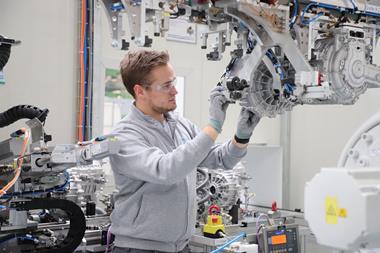
Raffaello Lepratti, VP of business development and marketing at Siemens looks at how suppliers can optimise the cost of quality while assuring OEM requirements
 The automotive industry is undergoing massive structural change, as the advent of new technologies coincides with rapidly changing customer preferences. Recent developments suggest this disruption will accelerate as a result of four megatrends – shared mobility, autonomous driving, digitisation and electrification.Automotive suppliers will need to prepare for several distinct changes that are emerging: slowing growth; accelerated technological change; software as a key differentiator; commoditisation of hardware parts; and pressure on valuations for commoditised suppliers.
The automotive industry is undergoing massive structural change, as the advent of new technologies coincides with rapidly changing customer preferences. Recent developments suggest this disruption will accelerate as a result of four megatrends – shared mobility, autonomous driving, digitisation and electrification.Automotive suppliers will need to prepare for several distinct changes that are emerging: slowing growth; accelerated technological change; software as a key differentiator; commoditisation of hardware parts; and pressure on valuations for commoditised suppliers.
“Suppliers inevitably have to transform their existing business models – from overall strategy adaptation to the implementation of a lower operating cost base, from organisational structure adaptation to creation of a new innovation mindset,” says Ron Zheng, a partner at global strategy consulting firm Roland Berger.“Added value in conventional driving technology will continue to shift to suppliers, transferring more responsibility and a bigger part of the automotive value chain to them,” states Michael W. Rüger, senior partner at Roland Berger. “Suppliers will have the opportunity to climb up the added value hierarchy, eventually putting some on an equal footing with OEMs.
Peak performance in individual areas will no longer be sufficient for success. Suppliers need to opt for a holistic approach to transformation, in order to meet rapidly changing OEM requirements. To achieve this goal, a holistic approach to enterprise quality management becomes of vital importance.
How is the concept of quality management evolving for manufacturers?
Digitalisation and competition are creating urgency for a holistic quality management approach in discrete industries. Automotive suppliers feel this urgency even more than other manufacturers, due to the changing nature of their role and responsibilities, with respect to OEMs. The latter are pushing more of the engineering and configuration requirements of the end customer to tier suppliers, which are now not only executing the manufacturing of a product, but are also in charge of engineering it.
That’s why the ability to support quality management throughout the entire product lifecycle – from design (or ideation) to the execution of manufacturing of the product (realisation) to performance in the field (utilisation) – is no longer an option.
Quality is no longer synonymous with product integrity alone: instead, it is a company’s on-going commitment to excellence across all the departments, individuals and processes involved in developing the product (including 2018sustainability, regulatory requirements, quality enforcement, cost reduction and efficiency, prevention of failures, standard reporting, lessons learned and know-how transfer, etc.). Traditionally, companies have managed quality internally, relying on in-house teams that mostly use static documents or isolated applications for quality management tracking. However, businesses have begun to feel the need for something more robust to manage their ever-expanding and increasingly complex business requirements. This shift has given way to smarter modes of managing quality, in the form of QMS.
QMS software includes a structured collection of business objectives, policies, procedures and principles, dedicated to ensuring customer requirements are met, regulations and norms are respected, and improvement tools are implemented, to reduce cost and manage quality efficiently. Of course, the policies, procedures and work instructions are properly documented. This software also provides a framework that can perform data analysis, monitor and measure performance, and complete audits that adhere to process requirements. A documented outlook to quality management helps ensure efficient administration of product and process quality, through proper guidance of professionals at all management levels and across all departments of the organisation.
QMS, when integrated with other manufacturing control systems – such as manufacturing execution systems (MES), enterprise resource planning (ERP), customer relationship management (CRM), or product life cycle management (PLM) – can effectively streamline manufacturing operations by ensuring adherence to quality norms at all stages of product and process life cycles. This integrated approach supports the smooth flow of information across all process modules and departments. QMS empowers organisations with the freedom to create touch points throughout the entire value chain that can enable cross-functional collaboration and communication. Ideally, therefore, QMS should not be regarded as a separate department, vis-à-vis other manufacturing control systems.

A successful QMS will bridge and integrate all departments of the manufacturing value chain. A systematic and integrated approach to managing quality helps suppliers gain overall visibility into manufacturing, and develop actionable intelligence to proactively diagnose and prevent potential quality-related failures. Auto suppliers therefore benefit from reduced time-to-market, enhanced flexibility, improved traceability, decreased wastage, minimal rework and better efficiency. All of these process improvements translate into healthy revenue gains and better response to OEM requirements.
The Siemens approach
An increasing number of quality-related issues is driving the market for QMS software. Siemens PLM Software has been advancing in this area, with delivery of its cross-industry and closed-loop quality management software, Siemens QMS Professional, which has a 30-year history of providing quality management solutions. The software is based on the Plan-Do-Check-Act (PDCA) cycle and is designed to ensure continuous product lifecycle and supply chain improvement, by managing complexities involved in planning, and controlling and monitoring processes and corporate quality. The PDCA cycle in quality management elucidates the different phases of continuous improvement in the PLM and forms the crux of all quality management systems.
One of the main reasons behind manufacturers using QMS Professional is the flexibility and integration with existing Manufacturing Operations Management (MOM) and PLM systems. Ideally, quality planning begins right from the engineering design of a product and should be a required element during the entire manufacturing process. QMS Professional fulfils this criterion. The software also has the ability to integrate the management of Bills of Materials (BOM) and Bills of Process (BOP), and shares these engineering objects across Siemens Teamcenter with all other Siemens MOM portfolio elements, to enable risk management. Designed as a multi-lingual, multi-plant and cross-industry QMS solution, Siemens PLM Software follows industry-specific quality standards and helps manufacturers across sectors mitigate risks and potential failures before they occur.
Conclusion
The onset of digitalisation trends in manufacturing will further fuel the quest for finer quality. We are certain to see quality gaining a larger share of end-user investment than ever before. In other words, quality will cease to be an after-thought and transform into a quintessential part of operational strategy in the factories of tomorrow.A centralised approach to quality management is becoming increasingly critical. Siemens’ holistic, end-to-end approach to quality management has been developed through its in-depth understanding of the industrial environment. The approach can go a long way in helping manufacturers realise the extent of quality implications and derive benefits that will improve overall operational efficiency – resulting in the ROI they desire.www.siemens.com/mom
































